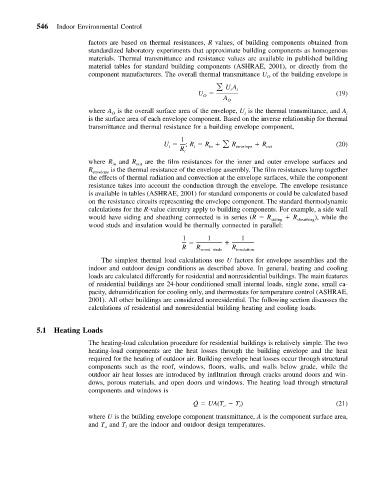Page 557 - Mechanical Engineers' Handbook (Volume 4)
P. 557
546 Indoor Environmental Control
factors are based on thermal resistances, R values, of building components obtained from
standardized laboratory experiments that approximate building components as homogenous
materials. Thermal transmittance and resistance values are available in published building
material tables for standard building components (ASHRAE, 2001), or directly from the
component manufacturers. The overall thermal transmittance U of the building envelope is
O
UA
U i i (19)
O
A O
where A is the overall surface area of the envelope, U is the thermal transmittance, and A i
i
O
is the surface area of each envelope component. Based on the inverse relationship for thermal
transmittance and thermal resistance for a building envelope component,
1 ; R R
U i in R envelope R out (20)
i
R
i
where R and R are the film resistances for the inner and outer envelope surfaces and
in out
R is the thermal resistance of the envelope assembly. The film resistances lump together
envelope
the effects of thermal radiation and convection at the envelope surfaces, while the component
resistance takes into account the conduction through the envelope. The envelope resistance
is available in tables (ASHRAE, 2001) for standard components or could be calculated based
on the resistance circuits representing the envelope component. The standard thermodynamic
calculations for the R-value circuitry apply to building components. For example, a side wall
would have siding and sheathing connected is in series (R R R ), while the
siding sheathing
wood studs and insulation would be thermally connected in parallel:
1 1 1
R R wood studs R insulation
The simplest thermal load calculations use U factors for envelope assemblies and the
indoor and outdoor design conditions as described above. In general, heating and cooling
loads are calculated differently for residential and nonresidential buildings. The main features
of residential buildings are 24-hour conditioned small internal loads, single zone, small ca-
pacity, dehumidification for cooling only, and thermostats for temperature control (ASHRAE,
2001). All other buildings are considered nonresidential. The following section discusses the
calculations of residential and nonresidential building heating and cooling loads.
5.1 Heating Loads
The heating-load calculation procedure for residential buildings is relatively simple. The two
heating-load components are the heat losses through the building envelope and the heat
required for the heating of outdoor air. Building envelope heat losses occur through structural
components such as the roof, windows, floors, walls, and walls below grade, while the
outdoor air heat losses are introduced by infiltration through cracks around doors and win-
dows, porous materials, and open doors and windows. The heating load through structural
components and windows is
˙
Q UA(T T ) i (21)
o
where U is the building envelope component transmittance, A is the component surface area,
and T and T are the indoor and outdoor design temperatures.
i
o

